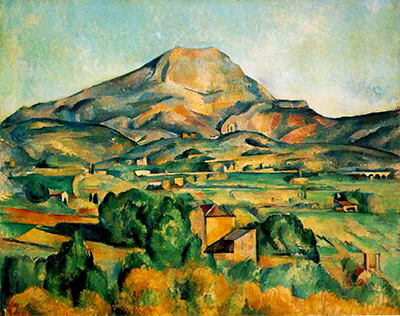Paul Cezanne was throughout his lifetime in awe at the Mont Sainte-Victoire, which overlooked and commanded the scenery in Cezanne's hometown, Aix-en-Provence.
Such was Cezanne's love and reverence for the mountain, he would in 1901 buy a plot of land overlooking the Mont Saint Victoire, on which he built a studio.
The mountain, furthermore, frequently appears as a motif in Cezanne's paintings throughout his artistic career, of which this is just one example. This particular painting was created in 1895, when Cezanne was already well-developed as an artist.
By this point he had already adopted Post-Impression, and this painting clearly evidences that style. For example, the colouring is quite bright and suggests that Cezanne was not overly concerned for making a hyper-realistic representation of the mountain, and there is a relatively geometric approach to the depiction of the landscape, particularly the foreground.
Along with Mont Saint-Victoire, there is also depicted a number of objects in the foreground that are both natural and man-made; for example, the trees and smaller hills in front on the larger mountain, and the buildings that can be seen dotted around the landscape.
It is characteristic of Cezanne's painting of Mont Sainte-Victoire, which usually do not solely depict the mountain, but frequently also depict various other objects such as trees, houses and farming areas.
The use of colours and shapes in the painting clearly give the picture a great deal of perspective, yet with Mont Sainte-Victoire in its focus. The mountain appears at first glance to be very big and imposing, suggesting that it close-by to the viewing point.
However, on second glance, one can see that the houses in the foreground, which are pictured quite small, appear quite a lot closer than the mountain, yet still a fair distance from the viewing point. This suggests that in reality the mountain is yet further away from the viewing point than it first appears.
In one's mind this creates a tension, perhaps, between two different viewpoints; one of the mountain as immediate and imposing, and one of the mountain as much further away.
According to both viewpoints, though, the mountain is obviously commanding over the surrounding landscape, and this is typical of Cezanne's other representation of this location. This demonstrated the importance of Mont Sainte-Victoire to Cezanne as both an artist and a person.




